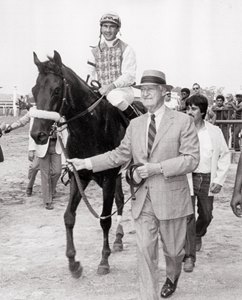BackTrack: Fit to Fight Delivers Memorable Met Mile Win


The Metropolitan Mile (G1), almost always a bright spot on the New York racing calendar, gleamed with its customary luster on a dark, rainy day in its 91st running at Belmont Park when Fit to Fight pulled even with A Phenomenon in midstretch.
These were the two expected to battle it out. Last year, A Phenomenon was the East's best sprinter. For two years, Fit to Fight had been a factor in New York's middle-distance stakes, winning or placing in six of them. They had met once before, in last year's seven-furlong Vosburgh (G1), and A Phenomenon had won with Fit to Fight second.
A Phenomenon, making his second start as a 4-year-old after a sharp third-place finish in the Carter (G2), was topweight at 126 pounds. Fit to Fight, making his third start as a 5-year-old, carried two pounds less.
Fit to Fight was 8-5 and A Phenomenon 2-1. Of their eight rivals only Bet Big, winner of the Carter, was given much chance of beating them. The Met was anticipated as an early season showdown between them—and this time—anticipation became reality.
After they had run only a few yards, they were one-two. A Phenomenon broke fast on the extreme outside and had the speed to cross the field and take the lead. Fit to Fight, which broke on the rail, does not have that quickness out of the gate and Mack Miller, his trainer, had said before the race that while his horse was fit, he himself was "sick" about drawing post position one.
Jerry Bailey, however, got sufficient speed out of Fit to Fight to get him in the clear on the rail before the others closed in. Dixieland Band, just outside of Fit to Fight, moved past him midway in the backstretch and momentarily was second, but save for that moment, it was A Phenomenon, ridden by Angel Cordero Jr., on the lead with Fit to Fight and Bailey trying to catch him.
At the three-eighths pole, Fit to Fight began to cut down the leader's narrow margin, inch by inch. The two were drawing away from the others now. At the eighth pole, A Phenomenon still had his head in front, but Fit to Fight still was gaining those inches. They raced stride-for-stride, on the same leads, to the wire, sometimes appearing to be a double image.
At the wire, the double image seemed blurred. Fit to Fight, the outside image, had his head in front and that was the margin by which he won. More than seven lengths back of them came Moro, circling the rest of the field from last place to take third money from Cozzene.
"I don't think he's ever run a better race," Miller said of Paul Mellon's Chieftain horse.
Fit to Fight was allergic to hay, of all things, at age 2; was a potential star at 3, when he won the Jerome (G2); and retained that promise but never quite fulfilled it at 4, when he won the Stuyvesant (G2) and placed in four other stakes. Now, he seems fitter to fight than ever before.
Angel Penna Jr., who trains A Phenomenon, has said frequently he thinks the son of Tim Tam is best at seven furlongs, although he was able to stretch him out to nine furlongs in winning the Jim Dandy (G2) last year. After seven furlongs of the Metropolitan Mile had been run, his horse was defending a slight lead, and considering that he was carrying two pounds more, racing secretary Lenny Hale's weights looked pretty good.
The Metropolitan is the first of New York's Handicap Triple races, followed by the 1 1/4-mile Suburban (G1) and the 1 1/2-mile Brooklyn (G1). Fit to Fight has not won at 10 furlongs, but Miller said the Suburban was the next goal.
"At 1 1/4 miles, the fractions are a little different," the trainer said in reference to the Met's fractions of :22 3/5, :22 1/5, :24, and :25 1/5. They added up to a 1:34 mile on a very moist but fast strip.
The race grossed $303,500 with Fit to Fight getting $182,100. The win money boosted his lifetime earnings to $612,175, although he has won only three stakes.
Addendum: Fit to Fight would sweep the New York Handicap Triple.
